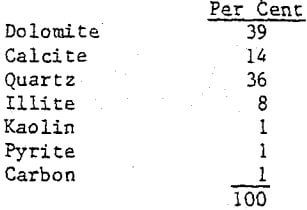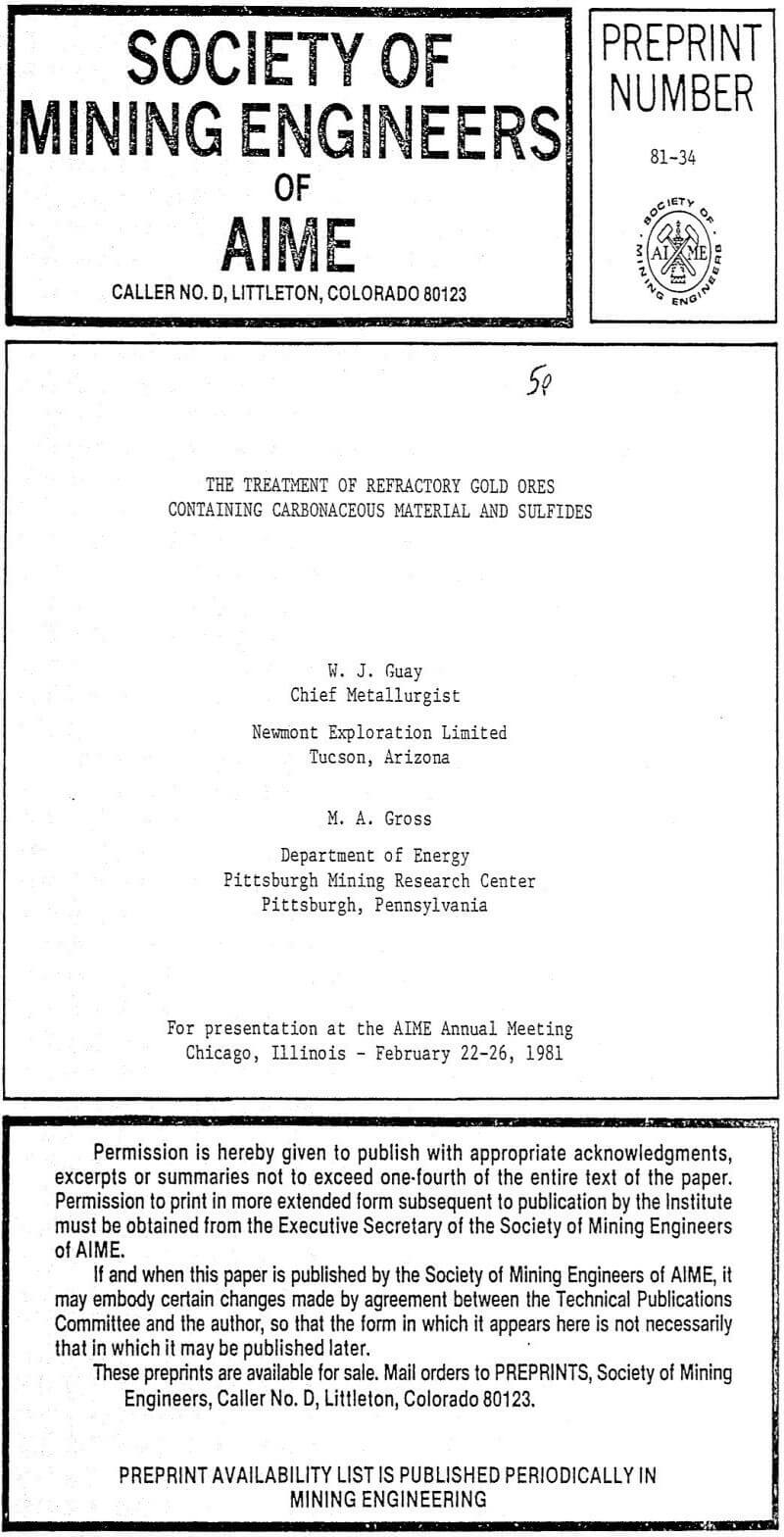Mineralogy and Occurrence of Gold: The term “carbonaceous” has been loosely applied to ore constituents of widely varying characteristics. Laboratory investigations by A. S. Radtke and B, J. Scheiner (1970) of the U. S. Geological Survey and the U. S. Bureau of Mines on carbonaceous ores from Carlin showed that they contained: (1) an activated carbon component capable of adsorbing gold chloride or gold chloride complexes from solution; (2) a mixture of high molecular weight hydrocarbons usually associated with the activated carbon components; and (3) an organic acid, similar to “humic acid” containing functional groups capable of interacting with gold complexes to form organic gold compounds. The structure of these compounds is not known. A possibility is that they are formed by chelation, where Ligands such as N, S, or O in organic acids form stable gold chelates.
Activated carbon in the Carlin ores is defined by the U. S. Bureau of Mines as fine grained amorphous carbon which will adsorb stable gold complexes. Little is known of the structure of the hydrocarbons. Approximately 0.012% hydrocarbon was removed by organic solvents from one Carlin sample. Removal of the hydrocarbon resulted in less gold extraction when the ore was treated by cyanidation, suggesting that the hydrocarbon was adsorbed on the activated carbon. Organic acid in the carbonaceous ore was extracted by heating the ore in 1 N NaOH solution. The pulp was filtered and the filtrate acidified with HCl. After acidification a gelatinous precipitate formed, consisting of SiO2, aluminum oxide, and 0.13-0.15% carbon. An infrared spectrum of the precipitate matches closely the spectrum of humic acid extracted from leonardite, a partially oxidized form of lignite from North Dakota. When the carbonaceous ore was treated with sodium hydroxide prior to cyanidation, the gold extraction increased significantly. When five grams of humic acid taken from leonardite was added to 100 grams of non carbonaceous cyanidable ore prior to cyanidation, gold extraction was reduced from 95 to 21 per cent. In another experiment the addition of five grams of humic acid to 25 ml. of a pregnant solution containing 0.032 grams of gold resulted in the humic acid adsorbing 84 per cent of the gold. All of these phenomena suggested that humic acid was chemically combined to the gold in the carbonaceous ores. Very strong supportive evidence that the gold was chemically combined was obtained in an experiment where a pulp of ground ore and ten per cent sodium chloride solution was electrolyzed for thirty minutes at pH 10.0 resulting in eighty per cent dissolution of the gold in the ore. With non carbonaceous ore containing gold in the metallic state, a similar experiment showed only eight per cent dissolution of gold.
Most of the Carlin carbonaceous ores contain from 0.4 to about 1.0 per cent organic carbon, with occasional samples as high as 4.0 per cent. Particle sizes vary from less than one µm to over 100 µm.
At the McIntyre Porcupine Mine, R. W. Nice (1971), the carbonaceous matter was identified as a disordered graphite structure with a small crystal size in the range of 0.002 to 0.005 µm.
The carbonaceous matter in the gold bearing carbon seams in the Witwatersrand ores of South Africa does not interfere with cyanidation, King (1949). It is described, J. E. Zumberge and A. C. Sigleo (1978), as a complex, solid, and solvent insoluble, polymer-like substance, containing mainly hydrocarbons and some organic sulfur and oxygen compounds.
Because the term “carbonaceous ore” cannot be rigorously defined, the classification of the ores at Carlin is arbitrary. Classification is by fire assay, atomic absorption (AA) assay on raw ore and on ore roasted at 500C, and by the “Preg Robbing” test previously described.
A positive “Preg Robbing” test is a rapid, certain way of identifying carbonaceous ores. However, some ores with a low carbonaceous content may not indicate carbon by the “Preg Robbing” test. The AA assay on raw or roasted samples is a hot cyanide leach of a small sample of pulverized ore, followed by an AA assay of the pregnant solution. If the AA assay on raw ore gives an extraction of over eighty per cent of the gold indicated by fire assay, the ore is amenable to cyanidation. Anything yielding less than eighty per cent extraction is refractory ore.
If a refractory ore gives over eighty per cent extraction by the AA assay on a roasted sample, the refractoriness is due to either carbonaceous material or sulfides. If the AA assay on the roasted sample shows less than eighty per cent extraction of gold, the refractoriness is due to gold lockup in the siliceous gangue. Work by A. S. Radtke and B. J. Scheiner (1970) of the U. S. Geological Survey and the U. S. Bureau of Mines classified Nevada ores containing 0.25-0.8 per cent organic carbon as carbonaceous ore and those containing 0.06 to 0.25 per cent organic carbon as non carbonaceous.
In addition to carbonaceous material, the Carlin type Nevada ores contain pyrite up to three per cent. Two types of auriferous pyrite at Carlin have been examined by a scanning electron microscope (SEM). Spheroidal pyrite occurs as isolated spherules or as clusters, showing high internal porosity, making it amenable to low temperature oxidation. It consists of numerous discrete pyrite crystallites, ranging from about 0.5 to nearly 2 µm in size that have aggregated to form spheroidal clusters that may range up to 20-30 µm in aggregate dimension.

Coarse, euhedral pyrite, 10 to 50 µm in size, is cubic with no internal porosity, thus making it much more difficult to oxidize at low temperatures.
Particulate forms of gold in pyrite were not detected in the SEM studies, and the gold is therefore either in solid solution or as finely occluded particles less than 0.02 µm (the resolution limit of the instrument).
As if the presence of carbonaceous material and auriferous pyrite was not enough of a problem, the Carlin ore also has from five to eight per cent illite, 1-9.5 per cent kaolin, and in some parts of the orebody a small amount of montmorillonite. These clay minerals can and have adsorbed the gold cyanide complex.

